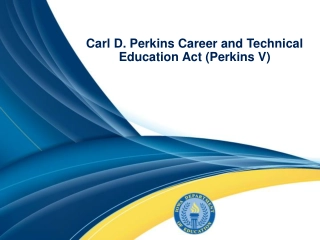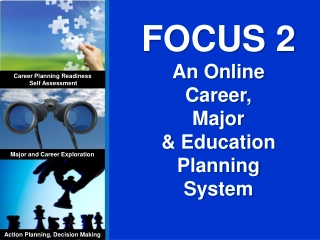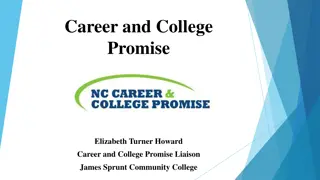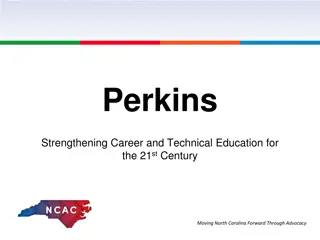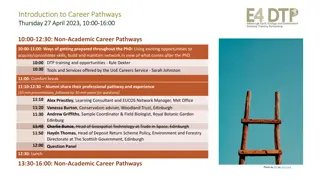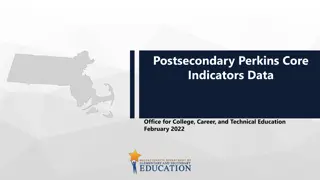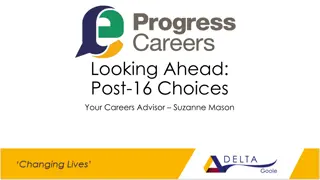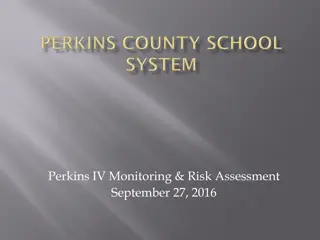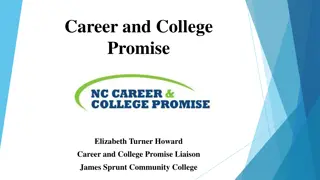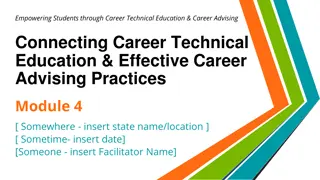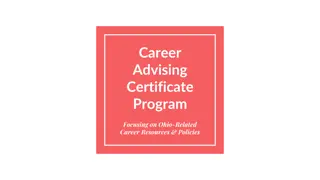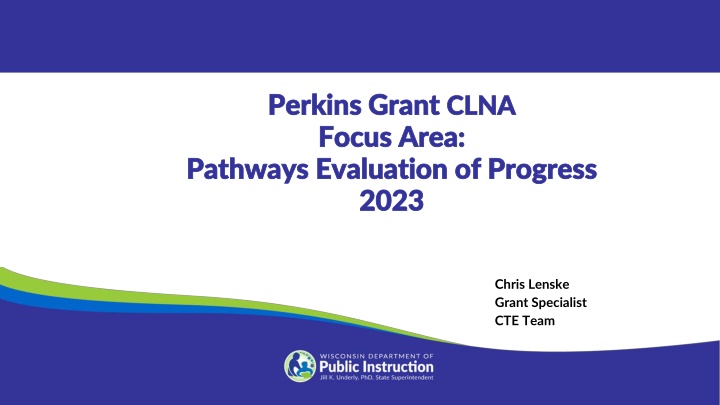
Career Pathways Evaluation and Data-Driven Decision Making Guide
This guide provides detailed information on conducting Career Pathways Evaluation, utilizing Labor Market Information (LMI), and implementing Data-Driven Decision Making for educational programs. It covers aspects such as analyzing accountability indicators, assessing educator recruitment and training, ensuring equity and access, and preparing for Perkins grant applications.
Download Presentation

Please find below an Image/Link to download the presentation.
The content on the website is provided AS IS for your information and personal use only. It may not be sold, licensed, or shared on other websites without obtaining consent from the author. If you encounter any issues during the download, it is possible that the publisher has removed the file from their server.
You are allowed to download the files provided on this website for personal or commercial use, subject to the condition that they are used lawfully. All files are the property of their respective owners.
The content on the website is provided AS IS for your information and personal use only. It may not be sold, licensed, or shared on other websites without obtaining consent from the author.
E N D
Presentation Transcript
Perkins Grant Perkins Grant CLNA Focus Area: Focus Area: Pathways Evaluation of Progress Pathways Evaluation of Progress 2023 2023 CLNA Chris Lenske Grant Specialist CTE Team
Wisconsins CLNA Guide Wisconsin s CLNA Guide CLNA Training Series I. Introduction and Overview of the CLNA requirement II. Focus Area: Performance on Accountability Indicators III. Career Pathway Evaluation (including LMI and SSQ) IV. Educator Recruitment, Retention and Training V. Focus Area: Equity and Access V. Putting it all together in preparation for the Perkins application https://dpi.wi.gov/cte/carl-perkins/grants/formula-grants
Data Driven Decision Making Data Driven Decision Making The Purpose of the CLNA requirement: Data-driven decision making Determine team Determine and gather data for the review and format Determine stakeholders and outreach/engagement strategies Analysis of data and determine root causes of gaps Create plan for closing data gaps Identify goals and develop strategic plan Identify impactful strategies/activities that will close the data gaps. (Which activities will be supported with Perkins funds?)
Career Pathways Evaluation of Progress Career Pathways Evaluation of Progress Labor Market Information (LMI) Size, Scope and Quality Pathway Evaluation of Progress
LMI Data Sources LMI Data Sources Industry Projection Reports and Emerging Occupations Reports on DPI s Labor Market Information page https://dpi.wi.gov/cte/labor-market- information/industry-projection-reports-career-cluster Websites on emerging occupations for your area: Regional Economic Development Organizations; Workforce Development Board; Chambers of Commerce and industry or trade associations Career pathway courses offered Related course syllabi to assess skills that are currently being taught
Occupational Openings Example Occupational Openings Example
LMI LMI Questions to explore Questions to explore What jobs related to your career pathway are projected to grow? How do the career pathways offered align with industry projections and emerging occupations? Are there other emerging jobs we should be preparing students for? What skills will they need in the future for these jobs and do we provide them? Are we teaching students the right skills for jobs that will be most in demand? What jobs/training/ do you want to most want to focus on? What gaps exist between what we are offering and what is needed? Between enrollment and projected job openings?
Assessing Pathway Size, Scope and Quality Assessing Pathway Size, Scope and Quality (SSQ) (SSQ) Size: Minimally, one career pathway that meets scope and quality elements. Scope: Progression of courses that build on each other & align with workforce needs. Quality: Course rigor and alignment to state academic standards and appropriately licensed educators are teaching the courses and at least 2 additional experiences 1) Work-based learning experiences specific to the pathway 2) Industry recognized credentials (IRCs) 3) Early college credit or dual credit specific to the pathway 4) CTSO aligned with the pathway
Data to Review Data to Review - - Size and Scope Size and Scope Size and Scope 1. The total career pathways that have a course sequence starting with introductory and building to more advanced course(s) 2. Course offerings: Sequences from introductory to more advanced with courses aligned to curriculum standards for each pathway. 3. Communications - type and frequency of communication regarding courses and quality offerings (WBL, IRCs, DC, CTSOs)
Data to Review Data to Review - - Quality Quality Quality The number of opportunities for extended/advanced learning in each pathway Demographics of students engaged in each quality element # of WBL opportunities and procedures for accessing opportunities # of dual credit agreements and the number of students who enroll and finish # of IRCs available vs. those obtained by students CTSO activities and alignment to career pathway curriculum
Data to Review Data to Review - - Pathway Evaluation of Pathway Evaluation of Progress Progress CTE vs. concentrator enrollments for the past several yrs. Total number of students who could be served vs. the number served Disaggregated data on which students persist and which students do not. Course offerings (frequency) vs. industry skill requirements Impact of programs - which students (demographically) pursue further training or work? Which do not? Student course interest (requests) vs. offerings Ongoing communication reflecting education opportunities in each pathway. Culture and Climate
Pathway Evaluation of Progress Pathway Evaluation of Progress - - Questions to explore explore Questions to Where are data gaps? How fully are my programs aligned and articulated across secondary and postsecondary education? Are a sufficient number of courses and course sections offered within each pathway year to year? Are there students who want to enroll in pathway courses but are unable to do so? Do some pathways lack employer engagement in either career-based learning experiences or work-based learning experiences? Which postsecondary education partnerships need further nurturing or support to move forward with college credit? Do some pathways offer more opportunities for skill development than others? How does each pathway offered compare in quality? What needs to be built up and what is needed?
Pathway Evaluation of Progress Pathway Evaluation of Progress - - Questions to explore Cont explore Cont Questions to Where are data gaps? In which career pathways are students of color or members of each special population group underrepresented? What type of trends do you see in pathway course enrollments. Who is a participant and who becomes a concentrator - and, who doesn't What proportion of students are accessing CTE pathways? Which students in which pathways have positive outcomes of further training or employment and which pathways and students do not?
Root Cause Analysis Root Cause Analysis Stakeholders provide the key answers WHY is something happening or not happening? When provided with the answer, ask WHY again and again until you get to the root cause (test your hypotheses with stakeholders) Determine the best way to address the root cause in a way that will lead to change
Career Pathway Evaluation of Progress - Overlap Career Pathway Evaluation of Progress overlaps, with other needs assessment focus areas. Consider if there are: Certain pathways that do better or worse when it comes to certain performance indicators? Opportunities for better alignment across academic, technical, and employability standards and curriculum [Performance on Accountability Indicators] Opportunities for use of instructional strategies that will support each student population who wishes to participate and move forward in a career pathway? [Equity and Access and ERRT] Untapped opportunities or strategies for supporting pathway faculty recruitment, retention & training in areas that will expand and enhance pathway offerings [ERRT]
ACTE Quality CTE Program of Study Self-Evaluation Tool PDF outline: https://www.acteonline.org/wp- content/uploads/2019/01/HighQualityCTEFramework2018.pdf PDF rubric for self scoring: https://www.acteonline.org/wp- content/uploads/2019/01/HighQualityCTEFramework2018_WithRubri c.pdf Online tool: https://www.acteonline.org/high-quality-cte-evaluation/
Christine Lenske Grant Specialist, CTE 608-266-3922 christine.lenske@dpi.wi.gov

